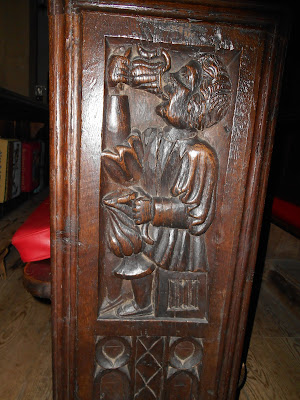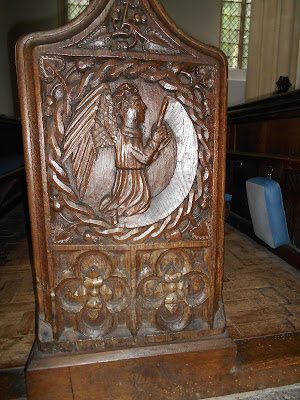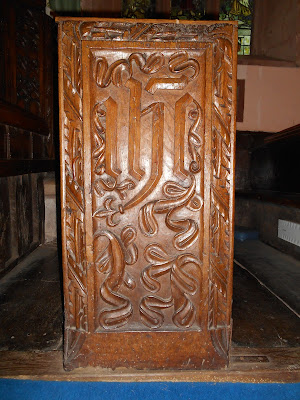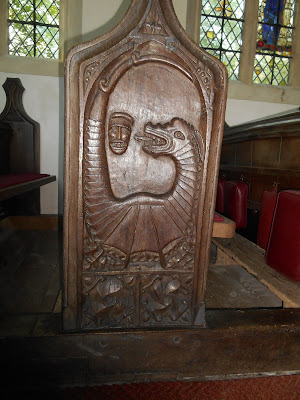Most of the surviving medieval bench ends in Somerset churches date from the 15th and 16th centuries. During this period seating was provided in churches: previously the congregations had stood for the duration of the services. Each church commissioned the carving of its own bench ends. The majority of bench ends were made of oak.
Very little is known about the people who carved bench ends in Somerset in the 15th and 16th centuries. The names of only two carvers are known: Simon Warman/Werman and Glosse. Simon Warman's name or initials appear on bench ends in several churches in the Taunton area. He was probably responsible for carving bench ends in the churches in East Quantoxhead, Monksilver, Bicknoller, Cothelstone, Bishop's Hull, Broomfield & Bishops Lydeard. Glosse is referred to in Stogursey's church records for 1524/5.
Bench ends can have poppyhead or horizontal tops. The bench end carvers may not have been the people who made and fitted the seats. Money from the wool trade probably paid for many of the carved bench ends.
There are 7 main types of carved bench ends:
- Symbols
- Birds
- Pelicans
- Green Men
- Quadrupeds
- People
- Plants
Symbols are usually either associated with the church or depictions of contemporary trades and crafts. Church symbols, which appear on bench ends include
- Signs of the passion (e.g. a cockerel)
- IHS (these are the 1st three letters of the name Jesus in Greek) or IHC (I & H are the 1st and 2nd letters of Jesus in Greek and C stands for Christus in Latin)
- The rosary
- Star of David
- Sacred Heart
- Holy water aspersorium and sprinkler
- Mitre and crosier
Symbols of trades and crafts include:- Windmills
- Farm equipment
- Weaving and clothmaking equipment
- Ships - wool trading vessels
- Woodworking tools
Birds which appear on Somerset bench ends include those depicted as pests (e.g. doves or pigeons eating grapes), doves with olive twigs returning to Noah's ark or representing the holy spirit, storks, spoonbills, game birds and numerous unidentified birds sitting in trees.Pelicans are symbols of piety and the eucharist. Pelicans are often depicted on bench ends feeding their own young with their own blood having plucked their own breasts. It is possible that pelicans were still living on the Somerset levels during the medieval period. However this may not be the case, as they aren't depicted with webbed feet, which implies that the carvers had never seen live pelicans.
Green Men are images of human faces associated with foliage. They may have their origins in ancient mythology. Alternatively their origins may lie with "wild-men" who lived in the woods on the fringes of society in the Middle Ages, for example Robin Hood. Or they could come from an innate part of the human psyche where the Green Man symbolises the realisation and acceptance that humanity and the world are inseparable.
There are three main types of Green Men:
- Those who have faces formed of leaves
- Those with faces where foliage comes out of the face, usually the mouth but occasionally the nose, ears or eyes. This is the most common type in medieval carvings in England
- Those whose face is set amongst the foliage.
Quadrupeds depicted on Somerset bench ends include real animals such as foxes, rabbits, stags, lions, horses, dogs, cats, badgers, lambs and cows and mythical creatures such as dragons and unicorns.
People on bench ends are usually either ecclesiastical (saints, angels, bishops, choristers, deacons etc) or local tradesmen (millers, woodcutters, archers, ale drinkers, clothiers, packhorse drivers, nightwatchmen, wrestlers etc).
Plants are the most common decorations on bench ends, either as the main feature or as infill on panels with a different main design.Ship, Bishops Lydeard
Pelican feeding its young, Bishops Lydeard
Sacred Heart, Bishops Lydeard
Anno Domini 1534, Crowcombe
There is an unusual trilogy of bench ends in St Michael's Church, Brent Knoll. They depict the downfall and execution of a fox dressed as a bishop. The fox may represent one of the Abbots of Glastonbury, but it is more likely that it represents Richard Fox, who was Bishop of Bath and Wells from 1492 to 1495. In 1519 he bought land in South and East Brent. He was disliked by the Abbot of Glastonbury and a man named John Fitzjames.
In the first scene the fox is dressed in vestments and is wearing a mitre and carrying a crozier. There are birds, including an owl and a cockerel around the edges and at the top. At the bottom of the main picture there are some animal heads. In the bottom panel 2 monkeys are shown roasting a boar on a spit over a fire.
In the top panel of the 2nd scene the fox has been stripped of his vestments and has cuffs around his hind legs. Various birds are depicted and there is a monkey (or it maybe a lion), which may be reading charges against the fox from a scroll. In the bottom panel the box has his legs in stocks and the monkey/lion is holding a halberd.
In the 3rd scene the fox is executed by hanging. The hanging is being carried out by 5 geese. Two hounds are underneath awaiting the body. A green man is depicted at the top of the bench, just under the poppyhead top.
Brent Knoll
Fox clothed as a bishop
Brent Knoll
Manacled fox
Brent Knoll
The fox is hanged by geese
Two men arguing, North Cadbury
Church and village, North Cadbury
Bearded man, North Cadbury
West Bagborough
Two mythical creatures at the top with flowers and foliage below, West Bagborough
Feathers, West Bagborough
East Quantoxhead
Luttrell coat of arms, centaur, unicorn, alpha & omega symbols
Stars of David, East Quantoxhead
Man, Nettlecombe
Wheat and vines on poppyead top, Kingston St Mary
Oxen and yoke with foliage and fruit below, Kingston St Mary
Rosary, Kingston St Mary
Hare below a goose, Kingston St Mary
Vase of flowers, Kingston St Mary
Weaver's shuttle below foliage, Kingston St Mary
Bench end dated 1522, Kingston St Mary
Ship, Milverton
Holy water aspersorium and sprinkler, Milverton
Man drinking ale, Milverton
Official Ship's Badge of HMS Finisterre, Milverton
A mythical seahorse is depicted on the badge, which was approved in 1945. HMS Finisterre was completed in 1945 and scrapped in 1967. I don't know what the connection is with Milverton.
Man, Milverton
Hatch Beauchamp
The risen Jesus stepping out of the tomb onto a guard with frightened guards on either side of him and a pelican feeding its young in the lower panel
Man, Chipstable
Holy water aspersorium and sprinkler, Chipstable
Green Man, Monksilver
Fish and sheep with candelabrum, Monksilver
Fish/serpent/eel?, Stogursey
Somerset Dyslexia Association, Milverton
Lamb and cross, Alford
Unicorn, Dunster
Angel, Brent Knoll
Angel & coats of arms, Churchstanton
Foliage, Combe Florey
Plants, Combe Florey
Vase of flowers, Combe Florey
IHC, Combe Florey
North Cadbury
Cat with mouse over mousetrap
Bird eating grapes, Cothelstone
Woman, Hatch Beauchamp
Man, Stogursey
Poppy head at St Julian's Church, Wellow
Green Man, Crowcombe
Dragon, North Cadbury
Stork or Heron, North Cadbury
Windmill with birds, miller and packhorse
Fox hunt, Monksilver
Candlestick, Monksilver
IHS, Monksilver
Packhorse and its driver, North Cadbury
Stag, Monksilver
Stag, Bishops Lydeard
Dragon, Alford
St George slaying the dragon, Dunster
Bat, Crowcombe
Dove with an olive twig in its beak, East Quantoxhead
Bishop's mitre and crosier, St Andrew's Church, Old Cleeve
Birds and Fruit, St Andrew's Church, Old Cleeve
Dragon, St Andrew's Church, Old Cleeve
A pair of shears and 4 teasels, Cheddon Fitzpaine
EG SG 1660, Cheddon Fitzpaine
Double-headed eagle, Cheddon Fitzpaine
Green man, Cheddon Fitzpaine
Simon Werman's name carved on a bench end in Broomfield Church
S = Simon, All Saints Church, Trull
W = Werman, All Saints Church, Trull
All Saints, Trull
Instruments of Christ's Passion: cross, ladder, pincers, hammer, lamp and the cockerel, which crowed to remind Peter that he had denied knowing Jesus three times.
Green man, All Saints, Trull
Stars of David, All Saints Church, Trull
This mask like head, which faces both ways, may be Janus. He was the Roman god after whom January is named. He is looking back to the old year and forward to the new.
All Saints Church in Trull also has 5 bench ends, which have characters from a pre-Reformation religious procession on them: Crucifer, Acolyte, Chorister, Deacon and Priest.
Crucifer carrying a cross
Acolyte carrying a tall candle
Chorister carrying a prayer or hymn book
Deacon carrying a casket and with a maniple over his arm
Further Reading:
Wright, Peter Poyntz: The Rural Bench Ends of Somerset: A study in medieval woodcarving. Published 1983 by Avebury Publishing Company



























































































